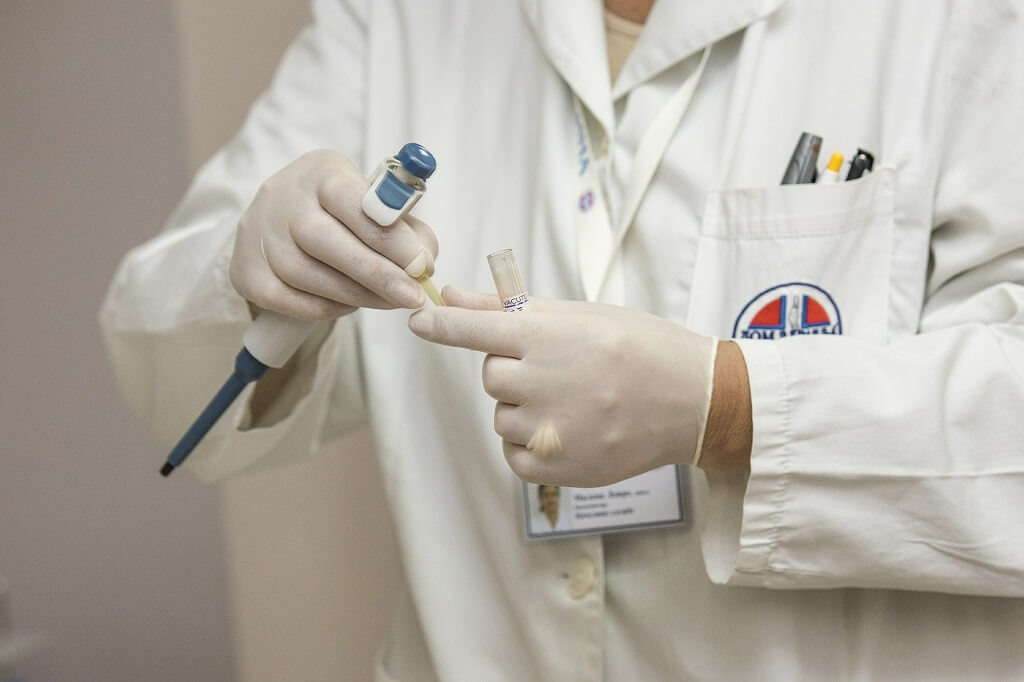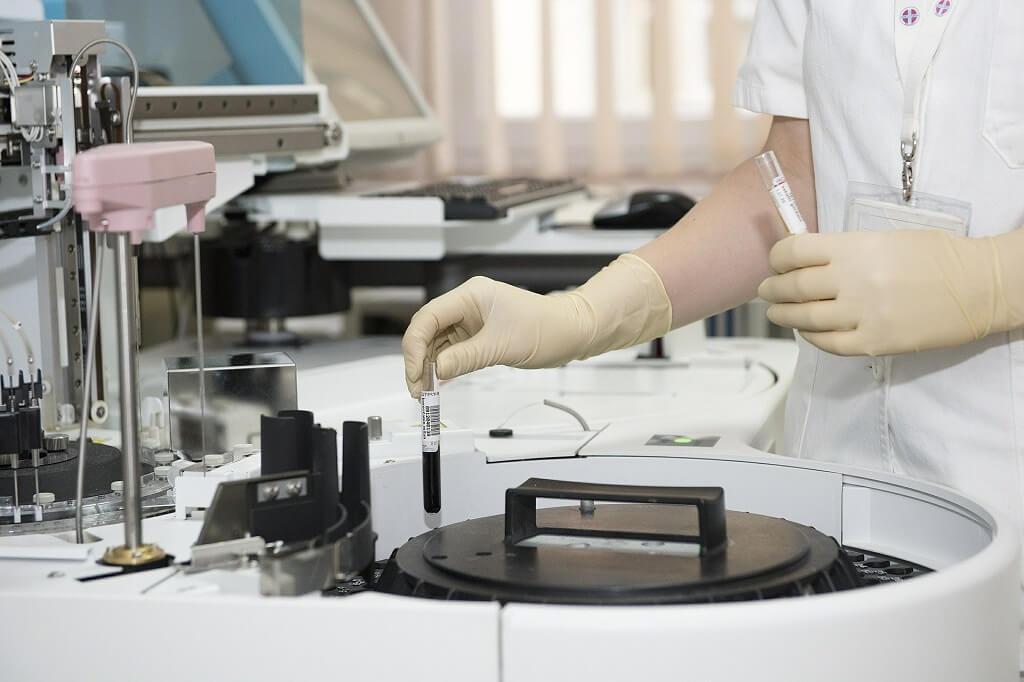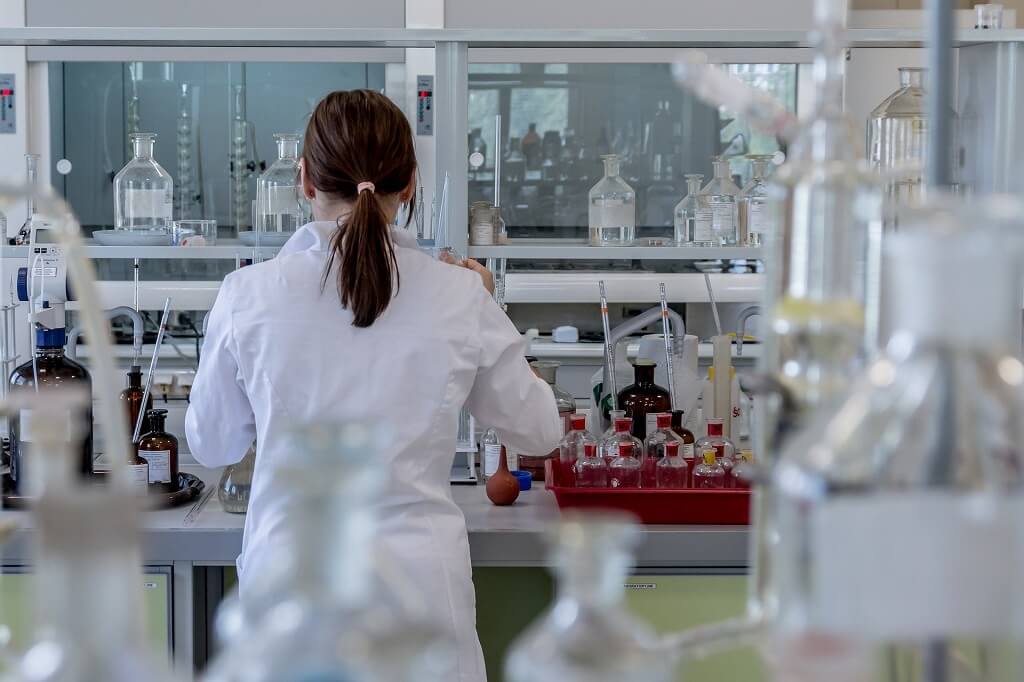MVA MoCoV 2 is a viral vector based vaccine designed to offer protection against the new SARS CoV 2 virus, which in 2020 triggered a pandemic of the infectious disease known as COVID 19.
As a response, UBATEC S.A. created the MVA MoCoV 2 Vaccine Research, Development and Production Unit, which is related to the Steering and Follow-up Coordination Committee of UBA’s COVID-19 Vaccine Project, and conducted by scientists in the Vaccine Research Center, Department of Immunology, School of Veterinary Sciences.
This vaccine was generated with the Modified Vaccinia Ankara (MVA) virus based on an in silico mosaic approach by using non infectious SARS CoV 2, MERS, and other coronaviruses antigens. Therefore, in addition to providing immunization against COVID 19, this vaccine is also effective to prevent diseases caused by other emerging coronaviruses, such as the Severe Acute Respiratory Syndrome (SARS) and the Middle East Respiratory Syndrome (MERS). The MVA viruses used as viral vectors are highly attenuated, are unable to cause disease, and have been modified so that they can carry genes of different coronaviruses, apart from their own genetic code, without causing infection.
MVA MoCoV 2 is currently in its preclinical phase, with studies being carried out in bats and domestic cats to assess toxicity and immunogenicity. After completing this phase, trials will start in healthy volunteers in the United States.
Leader: Dr Silvia Colavecchia
Deputy Leader: Dr Gabriel Capitelli
Deputy Leader: Dra Silvia Mundo
Laboratory: Vaccine Research Center, Department of Immunology, School of Veterinary Sciences
About SARS CoV 2
Coronaviruses are a large family of viruses that can cause disease in animals and human beings. In humans, they give rise to respiratory infections that range from the common cold to more severe conditions, such as the Middle East Respiratory Syndrome (MERS) and the Severe Acute Respiratory Syndrome (SARS).
The recently discovered coronavirus is SARS CoV 2, which causes a disease known as COVID 19. Both this virus and the resulting disease were unknown before the outbreak first reported in Wuhan (People's Republic of China) on December 31, 2019. Investigation on the origin of this virus is still ongoing.
About COVID 19
Coronavirus disease (COVID 19) is an infectious disease caused by a newly discovered coronavirus, SARS CoV 2. In March 2020, the World Health Organization (WHO) declared the COVID 19 outbreak a pandemic, which is currently affecting several countries globally.
Although most people with COVID 19 experience mild to moderate symptoms, the disease can lead to severe medical complications and even death. Among its complications are pneumonia, difficulty breathing, multiorgan failure, heart conditions, and acute respiratory distress syndrome.
Evidence shows that transmission occurs mainly person to person in close contact with one another. The virus spreads through respiratory droplets released when an infected person coughs, sneezes or speaks. Transmission can also occur by touching surfaces contaminated with the virus.
This vaccine is designed to offer protection against the rabies virus, the agent that causes rabies.
The general purpose of this project is to develop a bolus vaccine that is safe for individuals and the environment, and to offer protection from rabies originated in wild animals—vampire bats (Desmodus rotundus) and foxes (Vulpes sp) being the main reservoirs of human and animal infection.
The new vaccine candidate is a viral vector based vaccine developed from an in silico antigen design tool to create a mosaic glycoprotein (MoG) gene by using sequences available in the rabies phylogenetic group I glycoprotein. This sequence represents the strains more likely to be found in bats.
Development started in 2018 at the University of Wisconsin, US, with Dr Jorge Osorio as principal scientist. This project is in its first research and development years, currently in Argentina, with ongoing safety, immunogenicity, and efficacy preclinical studies in animal models, as well as toxicity studies.
Leader: Dr Gabriel Capitelli
Deputy Leader: Dra Silvia Mundo
Laboratory: Vaccine Research Center, Department of Immunology, School of Veterinary Sciences, UBA.
About the Rabies Virus
The rabies virus (RABV), belonging to the Lyssavirus genus, is the agent responsible for causing rabies. It affects mammals, both domestic and wild, including humans. It is found in the saliva and secretions of infected animals and is inoculated to humans when these animals attack and cause a bite lesion. Dogs are the main source of human rabies deaths, contributing up to 99% of all rabies transmissions to humans.
About Rabies
Rabies is an acute and infectious zoonotic viral disease caused by the rabies virus, which compromises the central nervous system causing encephalitis, with a fatality rate close to 100%.
Initial symptoms of rabies include a fever with pain or paresthesia at the wound site, unusual tingling, pricking, or burning sensation). As the virus spreads to the central nervous system, progressive inflammation of the brain and spinal cord develops leading to death.
Rabies can be prevented with vaccines, but, according to WHO, it causes tens of thousands of deaths every year, mainly in Asia and Africa.
The vaccine against the West Nile Virus (WNV)—the agent causing the West Nile fever—is a biotechnological vaccine developed with 3D bioprinting.
The main purpose of this project is to develop a particulate vaccine composed of polyester particles containing the most immunogenic WNV antigens (E, pre-M and NS1) with 3D bioprinting. This vaccine will be designed in modern and safe platforms with a low production cost.
This project started in 2020 and is currently in its first research and development years for vaccine candidates. The first step after 3D bioprinting is to determine the expression of viral proteins and the biological and chemical characterization of the resulting vaccine. The vaccine induced immune response will be tested in a murine model, and its innocuousness, safety and sterility will be assessed. In this last phase in vitro efficacy of the vaccine will be determined by mouse inoculation and a subsequent serum neutralization test.
Leader: Dr Gabriel Capitelli
Deputy Leader: Dra Silvia Colavecchia
Laboratory: Vaccine Research Center, Department of Immunology, School of Veterinary Sciences, UBA
About the West Nile Virus
The West Nile Virus (WNV), a member of the Flavivirus genus, is the agent responsible for causing West Nile fever. Birds are the natural hosts of the West Nile Virus and infections in humans are usually the result of mosquito bites; mosquitoes become infected when they feed on infected birds, which circulate the virus in their blood for a few days. The virus can infect humans, horses, and other mammals. Both humans and horses are final hosts, which means that they can become infected but do not spread the infection. The WNV can cause severe disease in horses.
About the West Nile Fever
The West Nile Fever is a viral disease transmitted to humans by infected mosquitoes. This disease originated in Sub Saharan Africa and causes encephalitis in horse and humans. Since 1937, it has spread throughout the rest of Africa, the Middle East, Asia Minor and Europe, and very recently to the Far East and North America.
The infection is asymptomatic in about 80% of infected individuals; in the rest, it can lead to West Nile Fever or severe forms of disease. The main symptoms include fever, headache, tiredness, body aches, nausea, vomiting, occasionally a skin rash (on the trunk of the body) and swollen lymph nodes.
According to WHO, approximately 1 in every 150 persons infected with the virus will develop a more severe form of disease, also known as neuroinvasive disease, such as encephalitis, West Nile meningitis or West Nile poliomyelitis.
Vaccines are available for use in horses but not yet for humans.
MAKONDE is an attenuated vaccine designed to offer protection against the chikungunya virus (CHIKV), the agent responsible for causing chikungunya fever.
The main purpose of this project is to create an attenuated viral strain vaccine model with tools like those used in the CRISPR/Cas system. This strain must retain the molecular patterns required for an adequate immune response with specific immunity, but without the potential of causing infection.
The vaccine candidates will be developed based on modern technologies that are safe and have a low production cost. CRISPR are families of repetitive DNA sequences in bacteria. The CRISPR/Cas system is a prokaryotic immune system offering resistance to the bacterium when challenged by external agents and provides a form of acquired immunity. The CRISPR/Cas system is an innovative genetic engineering tool that allows for modification of the coding sequences in target viral proteins, in this case, the chikungunya virus proteins.
This project started in 2019 and is currently in its first research and development years for vaccine candidates, as well as safety and efficacy studies in animal models.
Leader: Lisandro Maldonado
Laboratory: Department of Biology and Introduction to Cell Biology, School of Medicine, UBA
About the Chikungunya Virus (CHIKV)
The chikungunya virus (CHIKV), belonging to the Alphavirus genus, is the agent responsible for causing chikungunya disease. CHIKV is transmitted to humans by the bite of infected female mosquitoes of the Aedes aegypti and Aedes albopictus species. These mosquitoes are also vectors of the dengue, yellow fever and Zika viruses. The name of this virus derives from a word in the Makonde language meaning “to become contorted” and describes the stooped appearance of sufferers due to the severe arthralgia that characterizes the disease.
About Chikungunya Fever
The chikungunya fever is a viral disease transmitted to humans by infected mosquitoes. The most frequent symptoms are fever and severe joint pain, but it also causes other symptoms like muscle pain, joint swelling, headache, nausea, fatigue, and rash. Severe cases and deaths from chikungunya are very rare.
According to WHO, this disease is mainly present in Africa, Asia, and the Indian subcontinent. However, a major outbreak in 2015 affected several countries of the Region of the Americas, and sporadic outbreaks are seen elsewhere. The disease shares some clinical signs with dengue and Zika. Due to the challenge chikungunya poses for accurate diagnosis, there is no real estimate for the number of people affected by the disease globally on an annual basis.
As there is currently no vaccine or specific drug against the virus, the treatment is focused on relieving the disease symptoms.
This vaccine is designed to offer protection against the dengue virus (DENV), the agent responsible for causing dengue.
The general purpose of this project is to develop and assess vaccine candidates based on modern platforms that are safe and have a low production cost.
There is currently ongoing work on the expression of different viral antigens to design vaccines based on subunits and virus like particles (VLP) by using two biotechnological platforms based on P. pastoris and the insect baculovirus cell system to express and purify different antigens for the 4 DENV serotypes.
This project started in 2019 and is currently in its first research and development years for vaccine candidates. The first part of the project, involving the assessment and optimization of biotechnological processes, will be carried out at NANOBIOTEC, and the trials to determine the extent of immunogenicity and protection in animals will be carried out by ANLIS (Administración Nacional de Laboratorios e Institutos de Salud).
Leader: Dra María Victoria Miranda
Deputy Leader: Dr Julián Rodriguez Talou
Laboratory: NANOBIOTEC, CONICET UBA, School of Pharmacy and Biochemistry
About the Dengue Virus
The dengue virus (DENV), belonging to the Flavivirus genus, is the agent responsible for causing dengue. DENV is transmitted by female mosquitoes mainly of the species Aedes aegypti and, to a lesser extent, Ae. albopictus. These mosquitoes are also vectors of the chikungunya, yellow fever and Zika viruses.
There are four immunological serotypes of the dengue virus—DENV 1, DENV 2, DENV 3 and DENV 4. Recovery from infection provides lifelong immunity against the serotype that caused the infection. However, cross immunity to the other serotypes is only partial, and temporary. Subsequent infections by other serotypes increase the risk of developing severe dengue.
About Dengue
Dengue is a flu like mosquito borne viral infection that affects infants, young children, and adults. The infection causes flu like symptoms and occasionally this illness develops into a potentially lethal complication, called severe dengue.
Nowadays, dengue affects most Asian and Latin American countries and has become a leading cause of hospitalization and death among children and adults in these regions. As per WHO data, there are 390 million dengue virus infections per year, of which 96 million are manifested clinically (with any severity of disease).
There is no specific treatment for dengue or severe dengue. However, early detection and access to proper medical care lowers fatality rates to below 1%.
LEISHMAVAX is a prophylactic and therapeutic vaccine designed to offer protection against Leishmania, the parasite that causes leishmaniasis.
The purpose of this project is to develop and assess new immunogens for vaccines by using reverse vaccinology strategies to immunize animals with the developed candidates via adjuvants that promote a cellular response.
LEISHMAVAX vaccine is based on synthetic antigens with protein sequences that are highly preserved among species which are not homologous to the sequences in the parasite main hosts—dogs and humans. Sequences will be identified by using computer based immune prediction tools. Antigens will be synthesized, expressed, and tested in vitro and in vivo against Leishmania challenge.
This project started in 2020 and is currently in the first leg of a 3 year research and development cycle, which involves identification of epitopes by bioinformatics, the design of multiepitope antigens, synthesis of coding nucleic acids, antigen expression and purification, and in vitro and in vivo assays to study their immunogenic capacity and their efficacy to offer protection against leishmaniasis in the preclinical setting.
Leader: Dr Emilio Malchiodi
Laboratorios: LIME (Laboratorio de Inmunología Molecular y Estructural), Department of Immunology and IDEHU (Instituto de Estudios de la Inmunidad Humoral “Prof. Ricardo A. Margni”), CONICET UBA, School of Pharmacy and Biochemistry. LAVAX (Laboratorio de Vacunas), Department of Microbiology, Parasite Studies and Immunology, and IMPaM (Instituto de Microbiología y Parasitología Médica), CONICET UBA, School of Medicine.
About Leishmania
Leishmania is a protozoan parasite which is transmitted to humans by the bite of infected female phlebotomine mosquitoes, causing the disease known as leishmaniasis.
About Leishmaniasis
Leishmaniasis is an infectious disease caused by the protozoan Leishmania parasite. According to WHO data, an estimated 700,000 to 1 million new cases occur annually. There are three main forms of leishmaniases—visceral (the most serious form of the disease), cutaneous (the most common), and mucocutaneous.
The disease affects some of the poorest people on earth, and is associated with malnutrition, population displacement, poor housing, a weak immune system, and lack of financial resources. Fortunately, only a small fraction of those infected by Leishmania parasites will eventually develop the disease.
FIAMAVAX is a recombinant vaccine designed to offer protection against the yellow fever virus, the agent responsible for causing yellow fever.
The general purpose of this project is to develop and assess vaccine candidates against the yellow fever virus, based on modern platforms that are safe and have a low production cost, as alternatives to the already available 17D vaccine.
FIAMAVAX vaccine is based on the E protein on the viral envelope, modified by the addition of T epitopes. These epitopes are identified by using reverse vaccinology and can bind to different human major histocompatibility complex supertypes. This vaccine is based on recombinant proteins that will be expressed in an insect baculovirus cell system to form virus like particles (VLP).
This project started in 2019 and is currently in the first leg of a 3 year research and development cycle for vaccine candidates, which involves immunogenicity and efficacy studies in mice in the preclinical setting.
Leader: Dr Emilio Malchiodi
Laboratories: LIME (Laboratorio de Inmunología Molecular y Estructural), Department of Immunology and IDEHU (Instituto de Estudios de la Inmunidad Humoral “Prof. Ricardo A. Margni”), CONICET UBA, School of Pharmacy and Biochemistry. LAVAX (Laboratorio de Vacunas), Department of Microbiology, Parasite Studies and Immunology, and IMPaM (Instituto de Microbiología y Parasitología Médica), CONICET UBA, School of Medicine, and INBIRS (Instituto de Investigaciones Biomédicas en Retrovirus y SIDA), CONICET UBA, School of Medicine.
About the Yellow Fever Virus
The yellow fever virus belongs to the Flavivirus genus and is transmitted to humans by the Aedes Aegypti mosquito and the sylvatic Haemogogus species. It causes the disease known as yellow fever.
About Yellow Fever
Yellow fever is an acute viral hemorrhagic disease transmitted by infected mosquitoes. The virus is endemic in tropical and subtropical areas of Africa and Latin America. Clinical symptoms vary, ranging from a mild and self-limited febrile state (the most frequent presentation) to a severe hemorrhagic and liver disease (with a 50% fatality rate).
There is no treatment to cure yellow fever; therefore, vaccination is the most important preventive measure.
CRUZIVAX is a prophylactic and therapeutic recombinant vaccine designed to offer protection against Trypanosoma cruzi, the parasite that causes Chagas disease.
The vaccine, based on chimeric antigens combined with next generation adjuvants, is designed to be administered needle free via the intranasal route.
CRUZIVAX is based on Traspain, a recombinant polyvalent chimeric T. cruzi antigen adjuvanted with cyclic di-AMP (CDA), which has shown efficacy in the mouse model. The rational design of Traspain as a structure based trivalent antigen uses the N terminal domain of cruzipain (the main T. cruzi cysteine protease), an alpha helix region of trans sialidase, and the central domain of the amastigote surface protein 2 (ASP 2). The protein is expressed by E. coli as a recombinant antigen and it folds from inclusion bodies..
This project started in 2019 and is currently in the first leg of a 5 year research and development cycle, involving: safety, immunogenicity and efficacy preclinical trials in mouse, dog and non-human primate models; GLP and GMP production, toxicity assessment and the Phase 1 clinical trial in healthy volunteers.
Leader: Dr Emilio Malchiodi
Laboratories: LIME (Laboratorio de Inmunología Molecular y Estructural), LAVAX (Laboratorio de Vacunas), Department of Immunology, and IDEHU (Instituto de Estudios de la Inmunidad Humoral “Prof. Ricardo A. Margni”), CONICET UBA.
About Trypanosoma cruzi
Trypanosoma cruzi is a microscopic unicellular parasite that is present in triatomine bugs and is transmitted to humans via the feces of these insects when they feed (vector borne transmission).
About Chagas Disease
Chagas disease, also known as American trypanosomiasis, is a potentially life threatening illness caused by the protozoan parasite Trypanosoma cruzi (T. cruzi).
According to WHO, about 6 million to 7 million people worldwide are estimated to be infected with Trypanosoma cruzi, mainly in endemic areas of 21 Latin American countries, including Argentina. At present, there are no prophylactic or therapeutic vaccines for Chagas disease.
Up to 30% of chronically infected people develop cardiac alterations and up to 10% develop digestive, neurological or mixed alterations which may require specific treatment.
PSEUDOVAC is an inactivated bacterial vaccine developed by the Polish pharmaceutical company IBSS Biomed. This vaccine is designed to offer protection against hospital acquired infections. PSEUDOVAC promotes immunity against the “blue pus” bacterium, Pseudomonas aeruginosa, being the only one of its kind which is available globally.
This vaccine contains antigens from inactivated Pseudomonas aeruginosa strains, representing 7 clinically relevant immunotypes.
PSEUDOVAC is used in children and adults susceptible to the risk of infection and sepsis caused by Pseudomonas aeruginosa, particularly in patients with extensive burns. PSEUDOVAC is used in:
- prophylactic treatment: in order to achieve active immunity against infections caused by Pseudomonas aeruginosa;
- therapeutic treatment: in case of existing infections caused by Pseudomonas aeruginosa, in order to augment specific immunity and lower the risk of development of bacteremia (the presence of bacteria in the bloodstream) and septicemia (sepsis).
This vaccine is currently being studied in Phase II/III clinical trials for a new indication, to assess the safety and efficacy of different dose ranges, as well as the most frequent type and profile of adverse reactions.
Leader: Dr Gabriel Capitelli
Deputy Leader: Eduardo Avelleira
Laboratory: Department of Biology and Introduction to Cell Biology, School of Medicine, UBA.
About Pseudomonas aeruginosa
Pseudomonas aeruginosa is a species of gram negative bacteria. It is an opportunistic pathogen in humans and plants. These bacteria are present globally in soil and water, and grow in humid areas, as well as in expired or inactivated antiseptic solutions. They are occasionally present in areas of the skin of healthy individuals.
About Pseudomonas Infections
Pseudomonas aeruginosa can infect different areas in the body, particularly in individuals with severe medical conditions or hospitalized patients.
This opportunistic pathogen affects immunocompromised patients and usually infects the ears, lungs, and airways. It can cause pneumonia in patients on mechanical ventilation. Pseudomonas aeruginosa can also infect the urinary tract, the heart valves, and lesions in the postoperative setting, and also in trauma or burn patients. It can also result in other kinds of sepsis (generalized infections).



